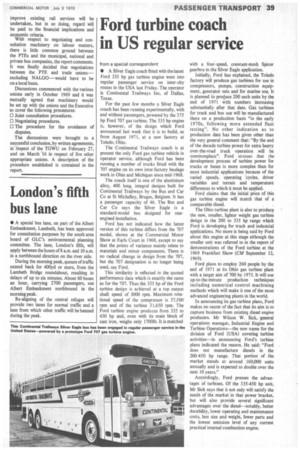Ford turbine coach in US regular service
Page 41

If you've noticed an error in this article please click here to report it so we can fix it.
from a special correspondent • A Silver Eagle coach fitted with the latest Ford 335 hp gas turbine engine went into regular passenger service on inter city routes in the USA last Friday. The operator is Continental Trailways Inc, of Dallas, Texas.
For the past few months a Silver Eagle coach has been running experimentally, with and without passengers, powered by the 375 hp Ford 707 gas turbine. The 335 hp engine is, however, of the design which Ford announced last week that it is to build, as from August 1971, at a new factory at Toledo, Ohio.
The Continental Trailways coach is at present the only Ford gas turbine vehicle in operator service, although Ford has been running a number of trucks fitted with the 707 engine on its own inter-factory haulage work in Ohio and Michigan since mid-1968.
The coach itself is one of the aluminium alloy, 40ft long, integral designs built for Continental Trailways by the Bus and Car Co at St Michelley, Bruges, Belgium. It has a passenger capacity of 46. The Bus and Car Co says the Silver Eagle is a standard-model bus designed for rearengined installation.
Ford has not indicated how the latest version of this turbine differs from the 707 model, shown at the Commercial Motor Show at Earls Court in 1968, except to say that the points of variance mainly relate to materials and minor components. There is no radical change in design from the 707, but the 707 designation is no longer being used, say Ford.
This similarity is reflected in the quoted performance data which is exactly the same as for the 707. Thus the 335 hp of the Ford turbine design is achieved at a top output shaft speed of 3000 rpm. Maximum rotational speed of the compressor is 37,500 rpm and of the turbine 31,650 rpm. The Ford turbine engine produces from 335 to 450 hp and, even with its main block of cast iron, weighs only I7001b. It is matched with a four-speed, constant-mesh Spicer gearbox in the Silver Eagle application.
Initially, Ford has explained, the Toledo factory will produce gas turbines for use in compressors, pumps, construction equipment, generator sets and for marine use. It is planned to procluce 200 such units by the end of 1971 with numbers increasing substantially after that date. Gas turbines for truck and bus use will be manufactured there on a production basis "in the early 1970s, following more extended fleet testing". No other indication as to production date has been given other than the very general comment that: "By the end of the decade turbine power for extra heavy over-the-road truck operation will be commonplace". Ford stresses that the development process of turbine power for trucks or buses is more complex than for most industrial applications because of the varied speeds, operating cycles, driver variables and terrain and temperature differences to which it must be applied.
Ford claims that the initial price of this gas turbine engine will match that of a comparable diesel.
The Ohio turbine plant is also to producp the new, smaller, lighter weight gas turbine design in the 200 to 335 hp range which Ford is developing for truck and industrial applications. No more is being said by Ford about this engine at this stage although the smaller unit was referred to in the report of demonstrations of the Ford turbine at the 1969 Frankfurt Show (CM September 12, 1969).
Ford plans to employ 260 people by the end of 1971 at its Ohio gas turbine plant with a target aim of 700 by 1975. It will use up-to-the-minute production techniques including numerical control machining methods which will make it one of the most advanced engineering plants in the world.
In announcing its gas turbine plans, Ford makes no secret of the fact that its aim is to capture business from existing diesel engine producers. Mr Wilson W. Sick, general operations manager, Industrial Engine and Turbine Operations—the new name for the division of Ford (USA) covering turbine activities—in ,announcing Ford's turbine plans indicated the reason. He said: "Ford does not manufacture diesels in the 200-450 hp range. That portion of the market stands at around 160,000 units annually and is expected to double over the next 10 years."
Accordingly, Ford presses the advantages of turbines. Of the 335-450 hp unit, Mr Sick says that it not only will satisfy the needs of the market in that power bracket, but will also provide several significant advantages over the diesel—notably, better durability, lower operating and maintenance costs, less size and weight, fewer parts and the lowest emission level of any current practical internal combustion engine.




































































































































































